Abstract
A model for the three-dimensional structure of insulin-like growth factor (IGF) is proposed based on the close sequence homology of IGF with insulin, the tertiary structure of which is known. The IGF molecule is postulated to have an insulin-like main chain conformation for residues equivalent to B6--B27 and A1--A21 and a hydrophobic core nearly identical to that of insulin. A short connecting peptide of twelve residues and an extension at the COOH-terminus are easily accommodated on the molecular surface. The surface involved in dimer formation in insulin is largely conserved, but the zinc-binding histidine and many residues involving hexamerization are very different from those of insulin and it is unlikely that IGF forms zinc hexamers. The model provides a ready explanation for the inability of IGF to bind antibodies to insulin and for its ability to bind insulin receptors with low affinity.
Full text
PDF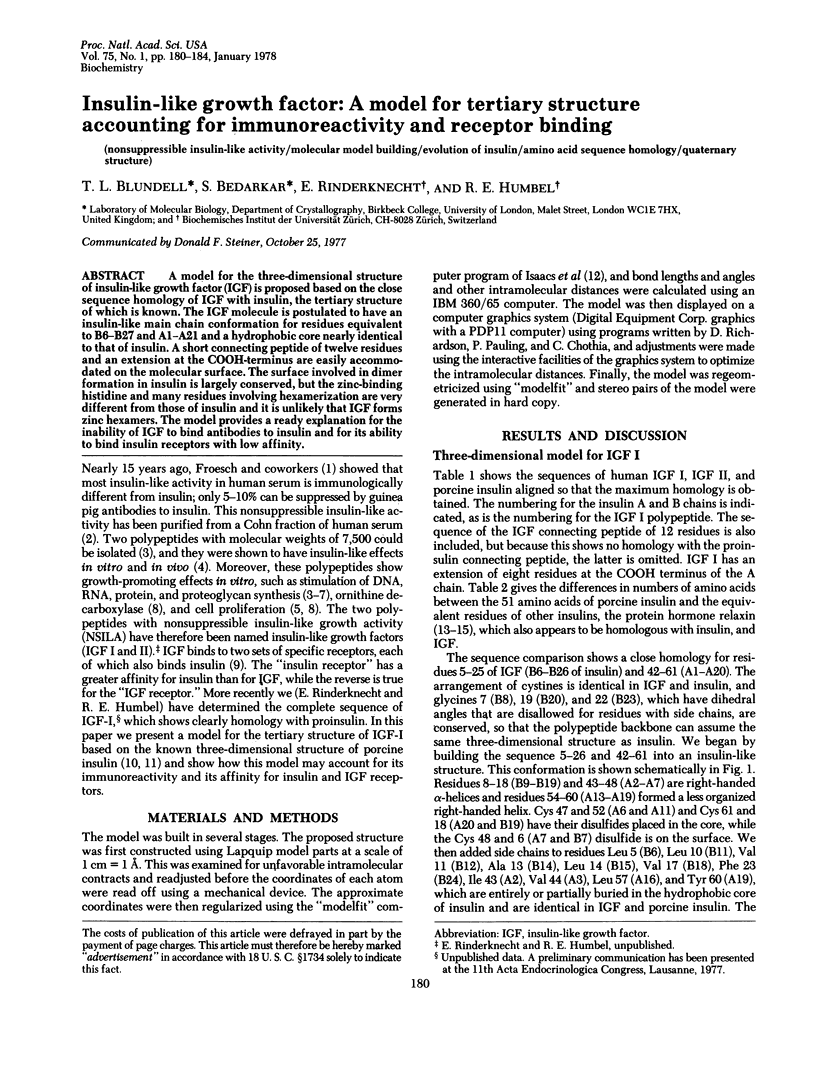
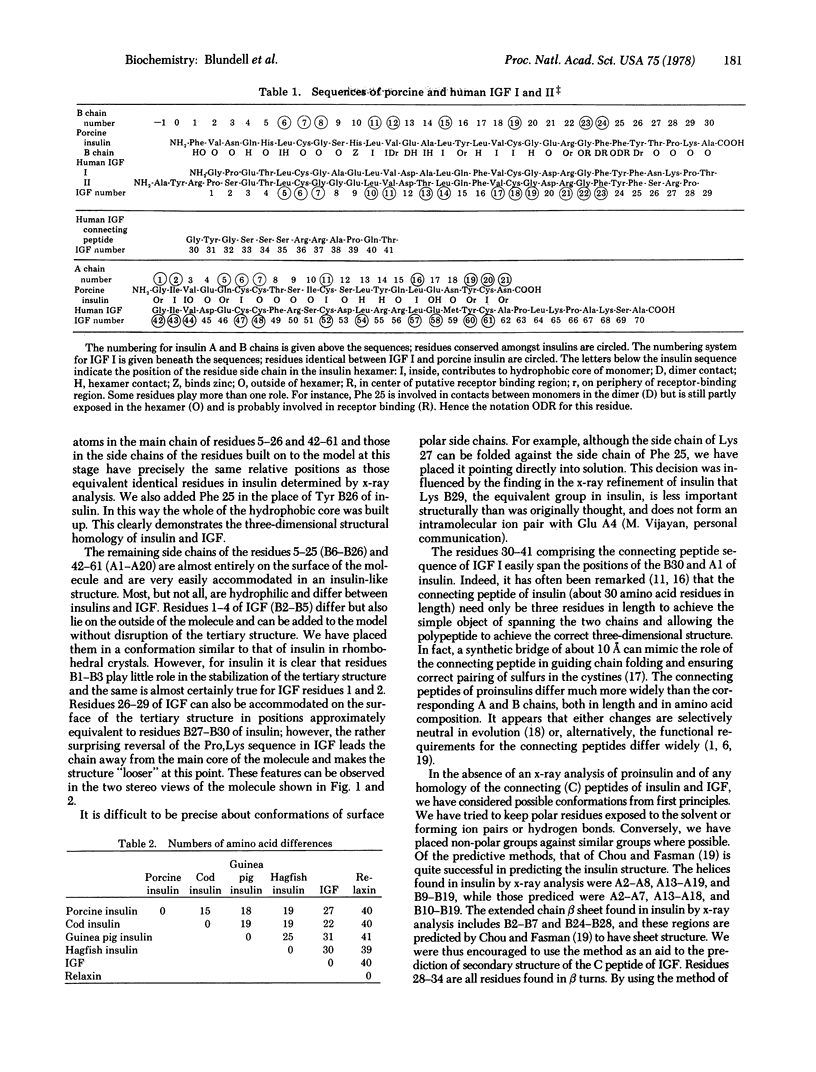
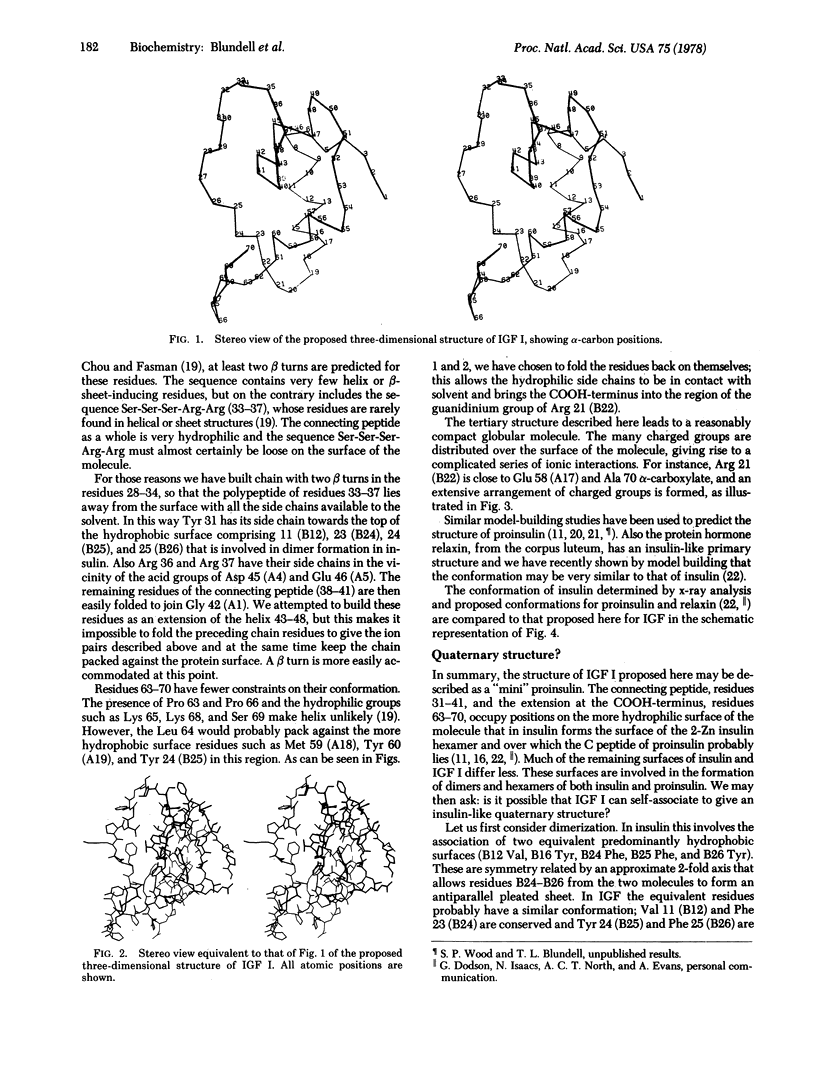
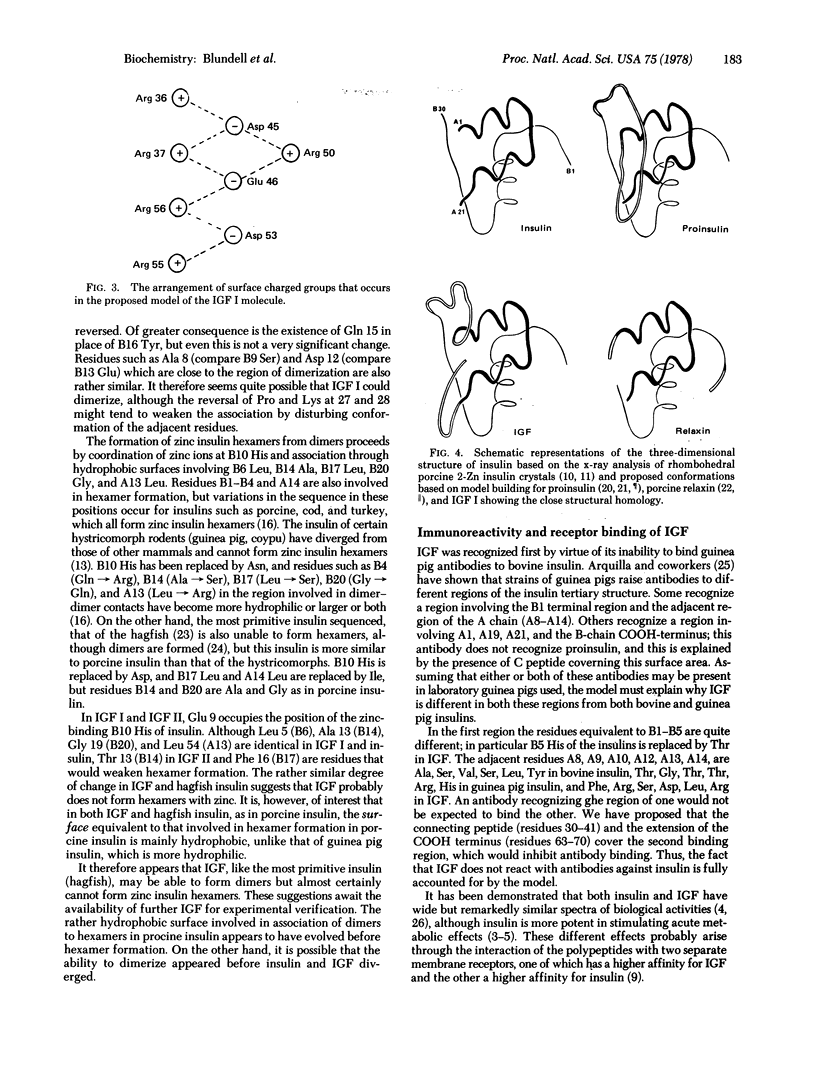
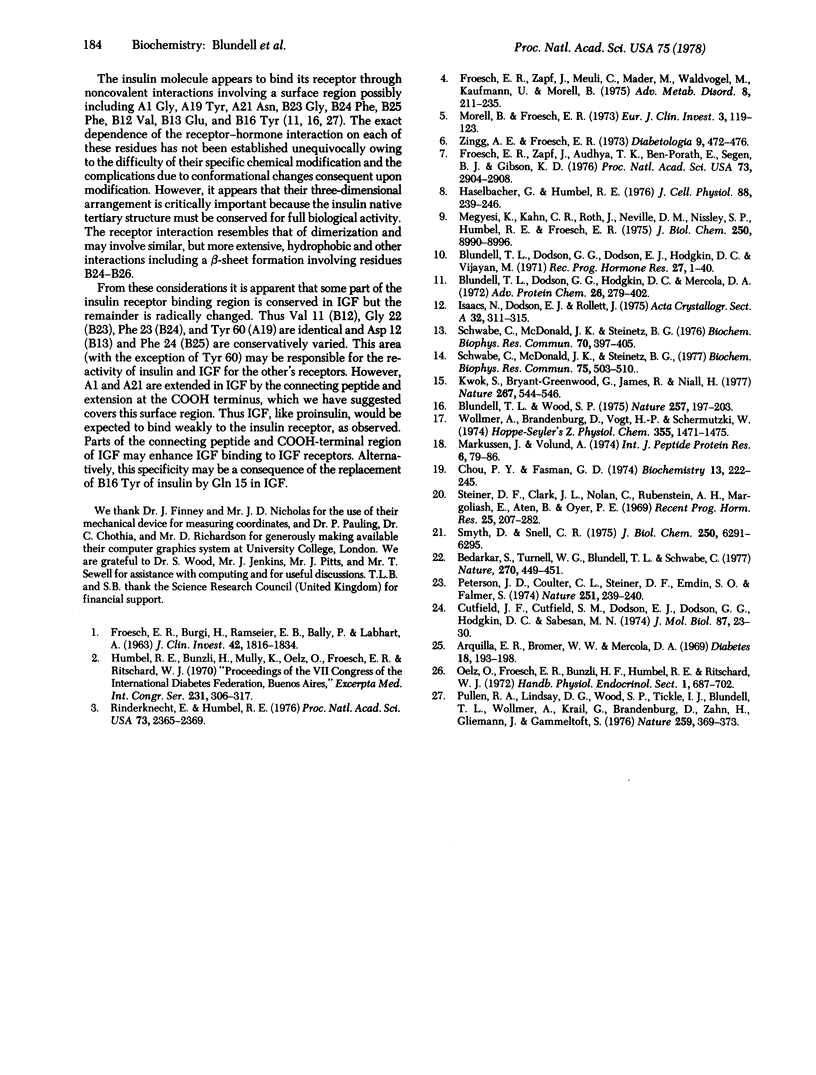
Selected References
These references are in PubMed. This may not be the complete list of references from this article.
- Arquilla E. R., Bromer W. W., Mercola D. Immunology conformation and biological activity of insulin. Diabetes. 1969 Apr;18(4):193–205. doi: 10.2337/diab.18.4.193. [DOI] [PubMed] [Google Scholar]
- Bedarkar S., Turnell W. G., Blundell T. L., Schwabe C. Relaxin has conformational homology with insulin. Nature. 1977 Dec 1;270(5636):449–451. doi: 10.1038/270449a0. [DOI] [PubMed] [Google Scholar]
- Blundell T. L., Dodson G. G., Dodson E., Hodgkin D. C., Vijayan M. X-ray analysis and the structure of insulin. Recent Prog Horm Res. 1971;27:1–40. doi: 10.1016/b978-0-12-571127-2.50025-0. [DOI] [PubMed] [Google Scholar]
- Blundell T. L., Wood S. P. Is the evolution of insulin Darwinian or due to selectively neutral mutation? Nature. 1975 Sep 18;257(5523):197–203. doi: 10.1038/257197a0. [DOI] [PubMed] [Google Scholar]
- Chou P. Y., Fasman G. D. Prediction of protein conformation. Biochemistry. 1974 Jan 15;13(2):222–245. doi: 10.1021/bi00699a002. [DOI] [PubMed] [Google Scholar]
- Cutfield J. F., Cutfield S. M., Dodson E. J., Dodson G. G., Sabesan M. N. Low resolution crystal structure of hagfish insulin. J Mol Biol. 1974 Jul 25;87(1):23–30. doi: 10.1016/0022-2836(74)90557-9. [DOI] [PubMed] [Google Scholar]
- FROESCH E. R., BUERGI H., RAMSEIER E. B., BALLY P., LABHART A. ANTIBODY-SUPPRESSIBLE AND NONSUPPRESSIBLE INSULIN-LIKE ACTIVITIES IN HUMAN SERUM AND THEIR PHYSIOLOGIC SIGNIFICANCE. AN INSULIN ASSAY WITH ADIPOSE TISSUE OF INCREASED PRECISION AND SPECIFICITY. J Clin Invest. 1963 Nov;42:1816–1834. doi: 10.1172/JCI104866. [DOI] [PMC free article] [PubMed] [Google Scholar]
- Froesch E. R., Zapf J., Audhya T. K., Ben-Porath E., Segen B. J., Gibson K. D. Nonsuppressible insulin-like activity and thyroid hormones: major pituitary-dependent sulfation factors for chick embryo cartilage. Proc Natl Acad Sci U S A. 1976 Aug;73(8):2904–2908. doi: 10.1073/pnas.73.8.2904. [DOI] [PMC free article] [PubMed] [Google Scholar]
- Froesch E. R., Zapf J., Meuli C., Mäder M., Waldvogel M., Kaufmann U., Morell B. Biological properties of NSILA-S. Adv Metab Disord. 1975;8:211–235. doi: 10.1016/b978-0-12-027308-9.50021-4. [DOI] [PubMed] [Google Scholar]
- Haselbacher G. K., Humbel R. E. Stimulation of ornithine decarboxylase activity in chick fibroblasts by non-suppressible insulin-like activity (NSILA), insulin and serum. J Cell Physiol. 1976 Jun;88(2):239–245. doi: 10.1002/jcp.1040880213. [DOI] [PubMed] [Google Scholar]
- James R., Niall H., Kwok S., Bryand-Greenwood G. Primary structure of porcine relaxin: homology with insulin and related growth factors. Nature. 1977 Jun 9;267(5611):544–546. doi: 10.1038/267544a0. [DOI] [PubMed] [Google Scholar]
- Markussen J., Volund A. New method of calculating evolutionary rates of proteins applied to insulin and C-peptides. Int J Pept Protein Res. 1974;6(2):79–86. doi: 10.1111/j.1399-3011.1974.tb02364.x. [DOI] [PubMed] [Google Scholar]
- Megyesi K., Kahn C. R., Roth J., Neville D. M., Jr, Nissley S. P., Humbel R. E., Froesch E. R. The NSILA-s receptor in liver plasma membranes. Characterization and comparison with the insulin receptor. J Biol Chem. 1975 Dec 10;250(23):8990–8996. [PubMed] [Google Scholar]
- Morell B., Froesch E. R. Fibroblasts as an experimental tool in metabolic and hormone studies. II. Effects of insulin and nonsuppressible insulin-like activity (NSILA-S) on fibroblasts in culture. Eur J Clin Invest. 1973 Mar;3(2):119–123. doi: 10.1111/j.1365-2362.1973.tb00338.x. [DOI] [PubMed] [Google Scholar]
- Peterson J. D., Coulter C. L., Steiner D. F., Emdin S. O., Falkmer S. Structural and crystallographic observations on hagfish insulin. Nature. 1974 Sep 20;251(5472):239–240. doi: 10.1038/251239a0. [DOI] [PubMed] [Google Scholar]
- Pullen R. A., Lindsay D. G., Wood S. P., Tickle I. J., Blundell T. L., Wollmer A., Krail G., Brandenburg D., Zahn H., Gliemann J. Receptor-binding region of insulin. Nature. 1976 Feb 5;259(5542):369–373. doi: 10.1038/259369a0. [DOI] [PubMed] [Google Scholar]
- Rinderknecht E., Humbel R. E. Polypeptides with nonsuppressible insulin-like and cell-growth promoting activities in human serum: isolation, chemical characterization, and some biological properties of forms I and II. Proc Natl Acad Sci U S A. 1976 Jul;73(7):2365–2369. doi: 10.1073/pnas.73.7.2365. [DOI] [PMC free article] [PubMed] [Google Scholar]
- Schwabe C., McDonald J. K. Primary structure of the B-chain of porcine relaxin. Biochem Biophys Res Commun. 1977 Mar 21;75(2):503–510. doi: 10.1016/0006-291x(77)91070-1. [DOI] [PubMed] [Google Scholar]
- Schwabe C., McDonald J. K., Steinetz B. G. Primary structure of the A chain of porcine relaxin. Biochem Biophys Res Commun. 1976 May 17;70(2):397–405. doi: 10.1016/0006-291x(76)91059-7. [DOI] [PubMed] [Google Scholar]
- Snell C. R., Smyth D. G. Proinsulin: a proposed three-dimensional structure. J Biol Chem. 1975 Aug 25;250(16):6291–6295. [PubMed] [Google Scholar]
- Steiner D. F., Clark J. L., Nolan C., Rubenstein A. H., Margoliash E., Aten B., Oyer P. E. Proinsulin and the biosynthesis of insulin. Recent Prog Horm Res. 1969;25:207–282. doi: 10.1016/b978-0-12-571125-8.50008-9. [DOI] [PubMed] [Google Scholar]
- Wollmer A., Brandenburg D., Vogt H. P., Schermutzki W. Reduction/reoxidation studies with cross-linked insulin derivatives. Hoppe Seylers Z Physiol Chem. 1974 Nov;355(11):1471–1476. [PubMed] [Google Scholar]
- Zingg A. E., Froesch E. R. Effects of partially purified preparations with nonsuppressible insulin-like activity (NSILA-S) on sulfate incorporation into rat and chicken cartilage. Diabetologia. 1973 Dec;9(6):472–476. doi: 10.1007/BF00461691. [DOI] [PubMed] [Google Scholar]


